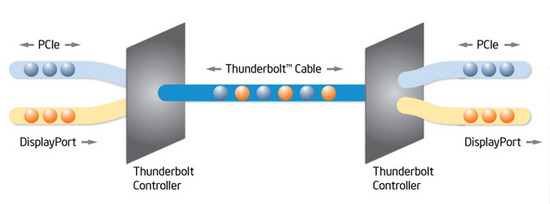Intel launched the Thunderbolt technology, but so far it is only available in Apple’s MacBook series, but from next year we will see better coverage among PCs and support from system builders. Intel has already discussed the successor to Thunderbolt, which will be capable of 50 Gb/s and be cheaper.
Intel Thunderbolt got a mild reception and so far we lack units with the new standard from Intel, but since Thunderbolt is a long term adoption to replace cables to and from a computer. Currently the biggest problem is that Thunderbolt is a proprietary standard, and way too expensive to be truly competitive with the open USB standard.
THe successor to Thunderbolt will according to Intel be a complement to what it has already released. The new generation will support speeds up to 50 Gb/s on a stretch of 100 meter, the cable will be the thinner both Thunderbolt and USB 3.0, and according to Intel it is working on making Thunderbolt an overall cheaper solution.
Intel’s Thunderbolt controller in Apple MacBook Pro
The new technology will just like modern microprocessors and circuits be built from silicon, but to scare up Thunderbolt to 50 Gb/s and running the stretch up to 100 meter it will introduce photon technology in the manufacturing process. It will also combine the transmitter and receiver into on and the same circuit in Thunderbolt, and shrink the circuit to reduce the cost, which is actually the biggest problem with the new technology. According to Intel the chip will be so smal that it could be used in smartphones and tablets without leave a too large footprint.
The new coverage for the next Thunderbolt technology will be smartphones, tablets, PCs and peripherals, e.g. external storage units. The resolution of monitors is expected quadruple in a couple of years, which puts pressure on the signaling technology used for your TV or monitor, which has been considered with the new Thunderbolt.

Currently Thunderbolt supports the protocols DisplayPort and PCI-Express, but the next generation will most likely support even more protocols to really be able to replace all cables with one.
Source: PCWorld
















